Use of Graphene Oxide to Improve the Durability and Mechanical Properties of Mortar Immersed in Flowing River for Three Years
Abstract
:1. Introduction
2. Materials and Methods
2.1. Materials and Casting Strategy
2.2. Experimental Methods
2.2.1. Water-Permeation Test
2.2.2. Chloride Penetration Test
2.2.3. Mercury Intrusion Porosimetry (MIP) Tests
2.2.4. Computed Tomography (CT) Tests
2.2.5. Mechanical Tests
3. Results and Discussion
3.1. Early-Age Water Permeation Coefficient
3.2. Chloride Penetration Resistance
3.3. Average Porosity and Pore Size Distribution
3.4. Spatial Distribution of Local Porosity
3.4.1. Mortars before, and after, River Immersing
3.4.2. Raw CT Data
3.4.3. Spatial Distribution of Local Porosity Based on Dual CT Scan
3.5. Mechanical Properties
3.5.1. Compressive Strength
3.5.2. Flexural Strength
3.5.3. Splitting Tensile Strength
4. Conclusions and Future Work
4.1. Conclusions
- (1)
- With the addition of GO nanoparticles, due to blocking of the permeation paths and increase on the crack tortuosity, the water permeation coefficient of mortar was reduced slightly during early curing age.
- (2)
- The chloride migration coefficients for standard-cured mortars were reduced by the range of 4.98–9.54% with the addition of GO, based on which GO incorporation was proven effective in confining the transport behaviors of mortar.
- (3)
- Based on MIP, the average open porosity of mortar, which controlled the ion migration properties of cementitious composites, would be reduced by the range of 3.37–11% with the incorporation of GO. Besides, the most probable pore radius would also be reduced after GO addition. Both results confirmed that GO addition refined the pore structure of mortar.
- (4)
- Based on dual CT scan, the local porosity for non-leached mortar was approximately 15%, while the local porosity for mortars after river experience can increased to as high as 30%. Compared with MIP, the porosity obtained through dual CT scan was closer to the total porosity of mortar, so the porosities here determined both the mechanical and ion migration properties of the tested specimens. The incorporation of GO cannot only improve the leaching resistance, but also enhance the cracking resistance of mortar, both of which can improve the durability and mechanical properties of mortars serving underwater.
- (5)
- With the addition of GO, the compressive strengths of standard-cured specimens could be improved by the range of 4.37–9.82%. Also, after a three-year river experience, the higher remaining compressive strengths were recorded for GO-incorporated mortars.
- (6)
- The flexural strengths of standard-cured mortars could be improved by the range of 7.78–22.33% with the addition of GO. Besides, the remaining flexural strengths of mortars were less reduced with the addition of GO.
- (7)
- The splitting tensile strengths of standard-cured mortars could be enhanced by the range of 8.14–28.73% when GO was added. Meanwhile, the splitting tensile strengths could on a larger extent be retained after three-year river experience for GO-incorporated mortars.
- (8)
- Judging from transport properties, microstructure and mechanical properties for mortars before and after three-year river experience, the optimum mix proportion for GO was determined to be 0.06 wt.% in the study.
4.2. Future Work
Author Contributions
Funding
Acknowledgments
Conflicts of Interest
References
- Ting, M.Z.Y.; Wong, K.S.; Rahman, M.E.; Meheron, S.J. Deterioration of marine concrete exposed to wetting-drying action. J. Clean. Prod. 2020, 278, 123383. [Google Scholar] [CrossRef]
- Yi, Y.; Zhu, D.; Guo, S.; Zhang, Z.; Shi, C. A review on the deterioration and approaches to enhance the durability of concrete in the marine environment. Cem. Concr. Compos. 2020, 113, 103695. [Google Scholar] [CrossRef]
- Cai, R.; Hu, Y.; Yu, M.; Liao, W.; Yang, L.; Kumar, A.; Ma, H. Skin effect of chloride ingress in marine concrete: A review on the convection zone. Constr. Build. Mater. 2020, 262, 120566. [Google Scholar] [CrossRef]
- Tang, Y.; Zuo, X.; Yin, G.; Davoudi, H.; Li, X. Influence of calcium leaching on chloride diffusivity in cement-based materials. Constr. Build. Mater. 2018, 174, 310–319. [Google Scholar] [CrossRef]
- Li, C.; Wu, M.; Chen, Q. Chemical and mineralogical alterations of concrete subjected to chemical attacks in complex underground tunnel environments during 20–36 years. Cem. Concr. Compos. 2018, 86, 139–159. [Google Scholar] [CrossRef]
- Zuo, X.; Tang, Y.; Yin, G.; Jiang, K.; He, S. Influence of fly ash and its partial replacement by slag on the leaching behavior of blended cement pastes. J. Mater. Civ. Eng. 2017, 29. [Google Scholar] [CrossRef]
- Erbektas, A.R.; Isgor, O.B.; Weiss, W.J. An accelerated testing protocol for assessing microbially induced concrete deterioration during the bacterial attachment phase. Cem. Concr. Compos. 2019, 104, 103339. [Google Scholar] [CrossRef]
- Choi, Y.S.; Choi, S.Y.; Kim, I.S.; Yang, E.I. Experimental study on the structural behaviour of calcium-leaching damaged concrete members. Mag. Concr. Res. 2017, 70, 1–39. [Google Scholar] [CrossRef]
- Liu, J.; Tang, K.; Qiu, Q.; Pan, D.; Lei, Z.; Xing, F. Experimental investigation on pore structure characterization of concrete exposed to water and chlorides. Materials 2014, 7, 6646–6659. [Google Scholar] [CrossRef] [PubMed] [Green Version]
- Tang, Y.; Zuo, X.; Yin, G.; He, S.; Ayinde, O. Influence of slag on leaching behavior of cement mortar lined in ductile iron pipe under a flowing solution. Mater. Des. 2017, 114, 612–622. [Google Scholar] [CrossRef] [Green Version]
- Momber, A.; Kovacevic, R. Fundamental investigations on concrete wear by high velocity water flow. Wear 1994, 177, 55–62. [Google Scholar] [CrossRef]
- Hu, H.; Zuo, X.; Cui, D.; Tang, Y. Experimental study on leaching-abrasion behavior of concrete in flowing solution with low velocity. Constr. Build. Mater. 2019, 224, 762–772. [Google Scholar] [CrossRef]
- Papayianni, I.; Anastasiou, E. Concrete incorporating high-calcium fly ash and EAF slag aggregates. Mag. Concr. Res. 2011, 63, 597–604. [Google Scholar] [CrossRef]
- Bhunia, P.; Pal, A.; Bandyopadhyay, M. Assessing arsenic leachability from pulverized cement concrete produced from arsenic-laden solid CalSiCo-sludge. J. Hazard. Mater. 2007, 141, 826–833. [Google Scholar] [CrossRef] [PubMed]
- Li, W.; Huang, Z.; Cao, F.; Sun, Z.; Shah, S.P. Effects of nano-silica and nano-limestone on flowability and mechanical properties of ultra-high-performance concrete matrix. Constr. Build. Mater. 2015, 95, 366–374. [Google Scholar] [CrossRef]
- Nunes, C.; Slížková, Z.; Stefanidou, M.; Němeček, J. Microstructure of lime and lime-pozzolana pastes with nanosilica. Cem. Concr. Res. 2016, 83, 152–163. [Google Scholar] [CrossRef]
- D’Alessandro, A.; Rallini, M.; Ubertini, F.; Materazzi, A.L.; Kenny, J.M. Investigations on scalable fabrication procedures for self-sensing carbon nanotube cement-matrix composites for SHM applications. Cem. Concr. Compos. 2016, 65, 200–213. [Google Scholar] [CrossRef]
- Zhan, M.; Pan, G.; Zhou, F.; Mi, R.; Shah, S.P. In situ-grown carbon nanotubes enhanced cement-based materials with multifunctionality. Cem. Concr. Compos. 2020, 108, 103518. [Google Scholar] [CrossRef]
- Meng, T.; Yu, Y.; Qian, X.; Zhan, S.; Qian, K. Effect of nano-TiO2 on the mechanical properties of cement mortar. Constr. Build. Mater. 2012, 29, 241–245. [Google Scholar] [CrossRef]
- Chu, H.; Jiang, J.; Sun, W.; Zhang, M. Effects of graphene sulfonate nanosheets on mechanical and thermal properties of sacrificial concrete during high temperature exposure. Cem. Concr. Compos. 2017, 82, 252–264. [Google Scholar] [CrossRef]
- Chu, H.; Ge, X.; Jiang, J.; Tang, J.; Zhang, Z. Mechanical properties and ablation behaviour of nuclear sacrificial materials containing graphene sulfonate nanosheets. Constr. Build. Mater. 2018, 19, 169–179. [Google Scholar] [CrossRef]
- Akarsh, P.K.; Marathe, S.; Bhat, A.K. Influence of graphene oxide on properties of concrete in the presence of silica fumes and M-sand. Constr. Build. Mater. 2020, 121093. [Google Scholar] [CrossRef]
- Lu, L.; Ouyang, D. Properties of cement mortar and ultra-high strength concrete incorporating graphene oxide nanosheets. Nanomaterials 2017, 7, 187. [Google Scholar] [CrossRef] [PubMed]
- Luo, J.; Chen, S.; Li, Q.; Liu, C.; Gao, S.; Zhang, J.; Guo, J. Influence of Graphene Oxide on the Mechanical Properties, Fracture Toughness, and Microhardness of Recycled Concrete. Nanomaterials 2019, 9, 325. [Google Scholar] [CrossRef] [PubMed] [Green Version]
- Sun, H.; Ling, L.; Ren, Z.; Memon, S.A.; Xing, F. Effect of Graphene oxide/graphene hybrid on mechanical properties of cement mortar and mechanism investigation. Nanomaterials 2020, 10, 113. [Google Scholar] [CrossRef] [PubMed] [Green Version]
- Du, S.; Wu, J.; AlShareedah, O.; Shi, X. Nanotechnology in cement-based materials: A review of durability, modeling, and advanced characterization. Nanomaterials 2019, 9, 1213. [Google Scholar] [CrossRef] [PubMed] [Green Version]
- García-Taengua, E.; Sonebi, M.; Hossain, K.M.A.; Lachemi, M.; Khatib, J. Effects of the addition of nanosilica on the rheology, hydration and development of the compressive strength of cement mortars. Compos. B Eng. 2015, 81, 120–129. [Google Scholar] [CrossRef]
- Sonebi, M.; García-Taengua, E.; Hossain, K.M.A.; Khatib, J.; Lachemi, M. Effect of nanosilica addition on the fresh properties and shrinkage of mortars with fly ash and superplasticizer. Constr. Build. Mater. 2015, 84, 269–276. [Google Scholar] [CrossRef]
- Lv, S.; Ma, Y.; Qiu, C.; Sun, T.; Liu, J.; Zhou, Q. Effect of graphene oxide nanosheets of microstructure and mechanical properties of cement composites. Constr. Build. Mater. 2013, 49, 121–127. [Google Scholar] [CrossRef]
- Li, Q.; Li, F.; Li, Y.; Du, Y.; Shih, T.; Kan, E. Hydrogen induced etching features of wrinkled graphene domains. Nanomaterials 2019, 9, 930. [Google Scholar] [CrossRef] [Green Version]
- Chu, H.; Zhang, Y.; Wang, F.; Feng, T.; Wang, L.; Wang, D. Effect of graphene oxide on mechanical properties and durability of ultra-high-performance concrete prepared from recycled sand. Nanomaterials 2020, 10, 1718. [Google Scholar] [CrossRef] [PubMed]
- Bhargava, A.; Banthia, N. Measurement of concrete permeability under stress. Exp. Tech. 2006, 30, 28–31. [Google Scholar] [CrossRef]
- Wang, Q.; Banthia, N.; Sun, W. Water permeability of repair mortars under an applied compressive stress at early ages. Mater. Struct. 2018, 51, 6. [Google Scholar] [CrossRef]
- Yonghao, F.; Zhongli, W.; Yue, Z. Time-dependent water permeation behavior of concrete under constant hydraulic pressure. Water. Sci. Technol. 2008, 1, 61–66. [Google Scholar]
- Wang, Q.; Banthia, N.; Sun, W.; Gu, C. Water Permeability of eco-friendly ductile cementitious composites (EDCC) under an applied compressive stress. Cem. Concr. Compos. 2020, 107, 103500. [Google Scholar] [CrossRef]
- GB/T 50082-2009. Standard for Test Methods of Long-Term Performance and Durability of Ordinary Concrete; China Architecture and Building Press: Beijing, China, 2009. [Google Scholar]
- Wan, K.; Li, Y.; Sun, W. Experimental and modelling research of the accelerated calcium leaching of cement paste in ammonium nitrate solution. Constr. Build. Mater. 2013, 40, 832–846. [Google Scholar] [CrossRef]
- Cui, D.; Sun, W.; Wan, K.; Banthia, N. Porosity characterization in interfacial transition zone using dual CT scans. J. Test. Eval. 2017, 45, 408–418. [Google Scholar] [CrossRef]
- Cui, D.; Zuo, X.; Zheng, K.; Talukdar, S. Tomography-based investigation on the carbonation behavior through the surface-opening cracks of sliced paste specimen. Materials 2020, 13, 1804. [Google Scholar] [CrossRef] [Green Version]
- Cui, D.; Sun, W.; Banthia, N. Use of tomography to understand the influence of preconditioning on carbonation tests in cement-based materials. Cem. Concr. Compos. 2018, 88, 52–63. [Google Scholar] [CrossRef]
- Atahan, H.N.; Oktar, O.N.; Taşdemir, M.A. Effects of water–cement ratio and curing time on the critical pore width of hardened cement paste. Constr. Build. Mater. 2009, 23, 1196–1200. [Google Scholar] [CrossRef]
- Yang, H.; Cui, H.; Tang, W.; Li, Z.; Han, N.; Xing, F. A critical review on research progress of graphene/cement based composites. Compos. Part A Appl. Sci. Manuf. 2017, 102, 273–296. [Google Scholar] [CrossRef]
- Palin, D.; Jonkers, H.M.; Wiktor, V. Autogenous healing of sea-water exposed mortar: Quantification through a simple and rapid permeability test. Cem. Concr. Res. 2016, 84, 1–7. [Google Scholar] [CrossRef]
- Wang, Y.; Yang, J.; Ouyang, D. Effect of graphene oxide on mechanical properties of cement mortar and its strengthening mechanism. Materials 2019, 12, 3753. [Google Scholar] [CrossRef] [Green Version]
- Wan, K.; Xu, Q.; Li, L.; Sun, W. 3D porosity distribution of partly calcium leached cement paste. Constr. Build. Mater. 2013, 48, 11–15. [Google Scholar] [CrossRef]
- Cui, D.; Banthia, N.; Wang, Q.; Sun, W. Investigation on porosity of partly carbonated paste specimens blended with fly ash through dual CT scans. Constr. Build. Mater. 2019, 196, 692–702. [Google Scholar] [CrossRef]
- Lu, Z.; Hou, D.; Ma, H.; Fan, T.; Li, Z. Effects of graphene oxide on the properties and microstructures of the magnesium potassium phosphate cement paste. Constr. Build. Mater. 2016, 119, 107–112. [Google Scholar] [CrossRef]
- Richardson, I.G.; Girão, A.V.; Taylor, R.; Jia, S. Hydration of water- and alkali-activated white Portland cement pastes and blends with low-calcium pulverized fuel ash. Cem. Concr. Res. 2016, 83, 1–18. [Google Scholar] [CrossRef] [Green Version]

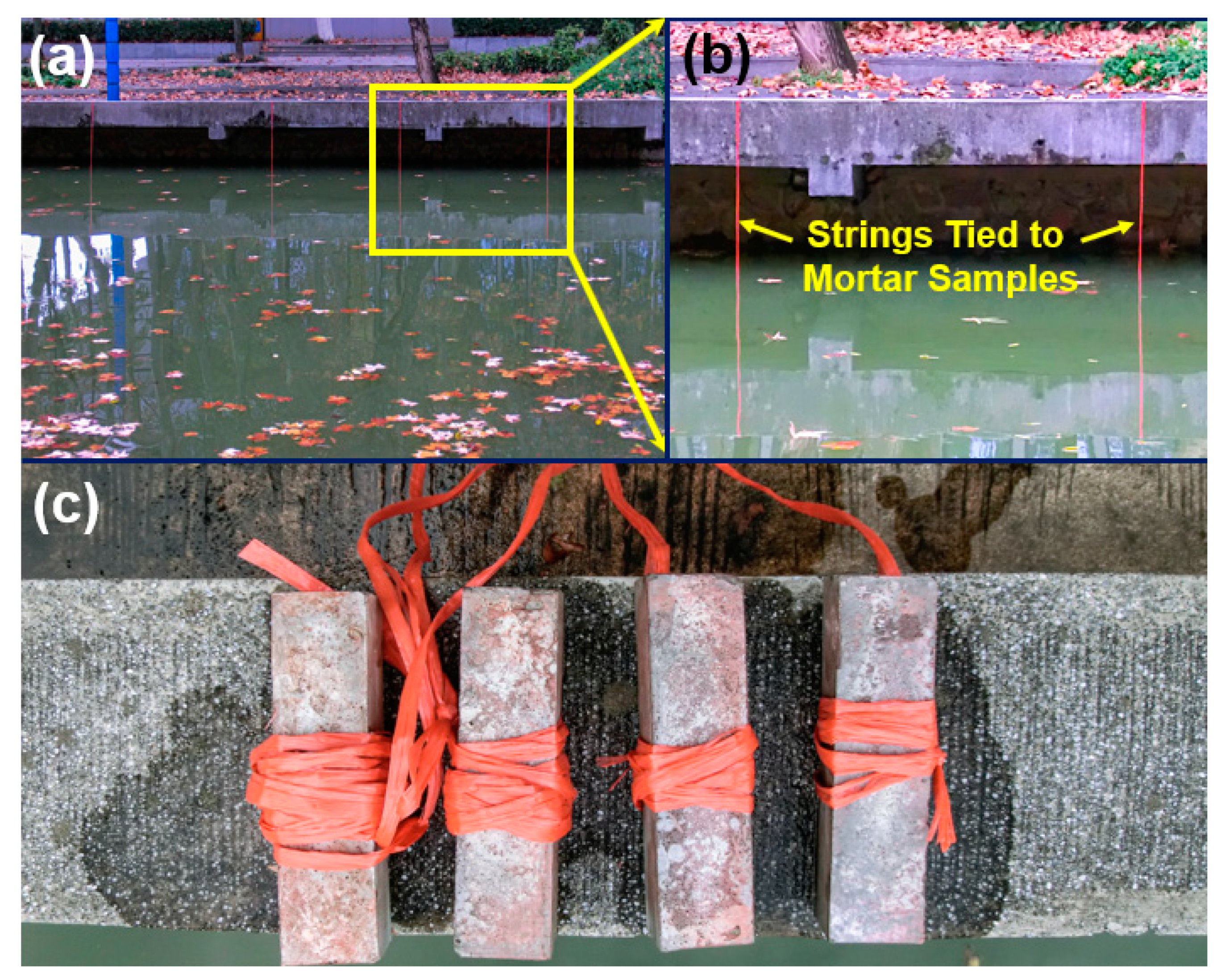

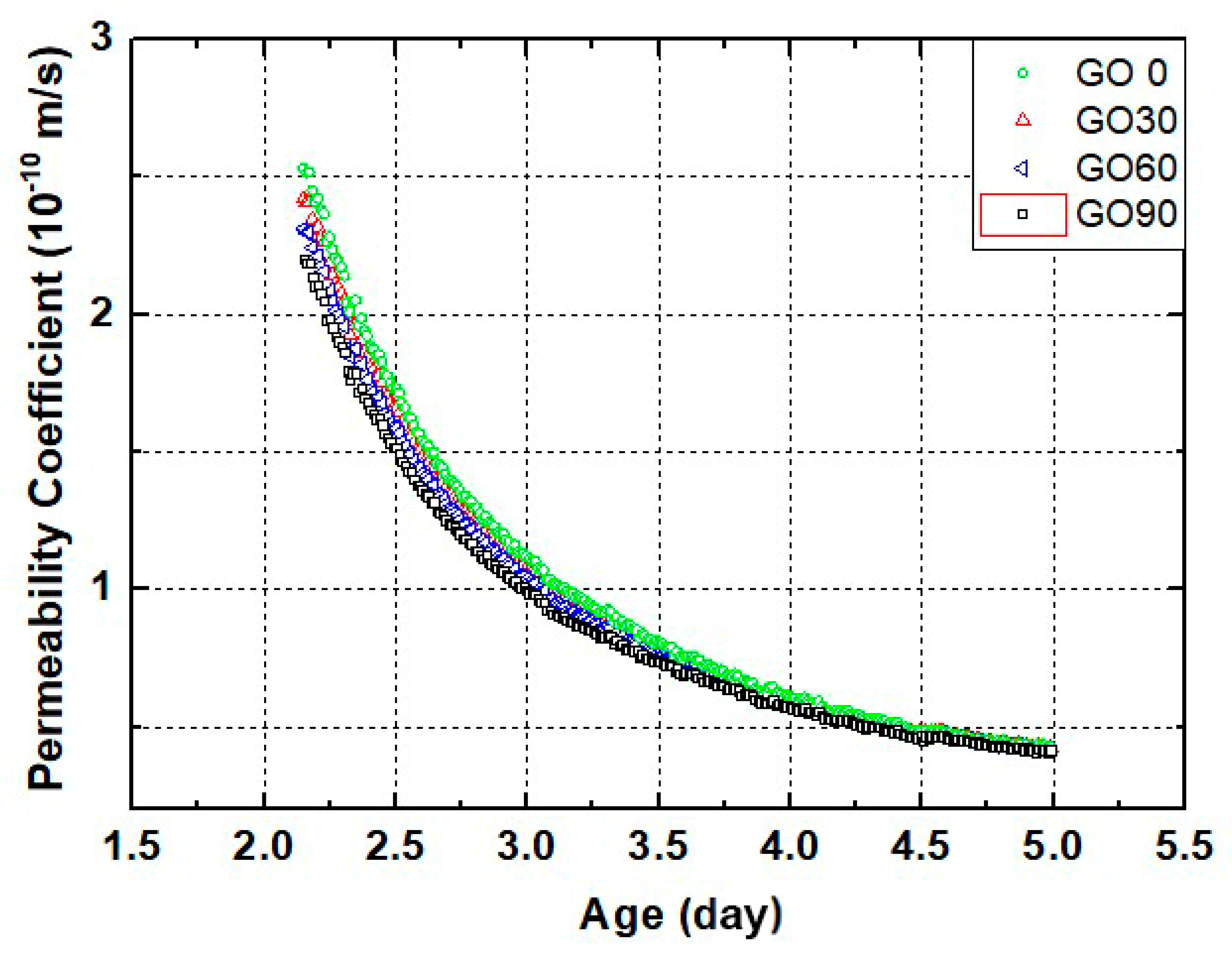

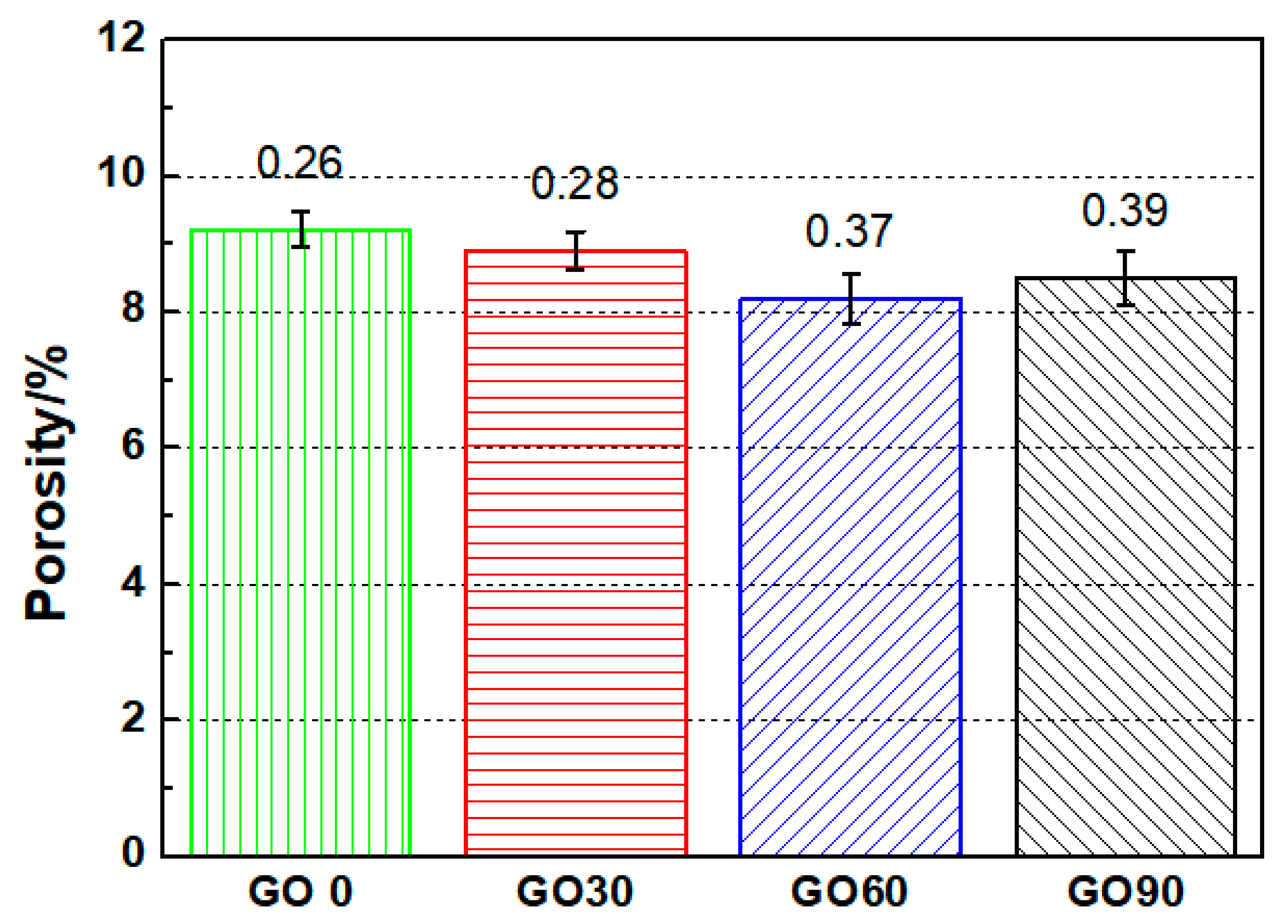



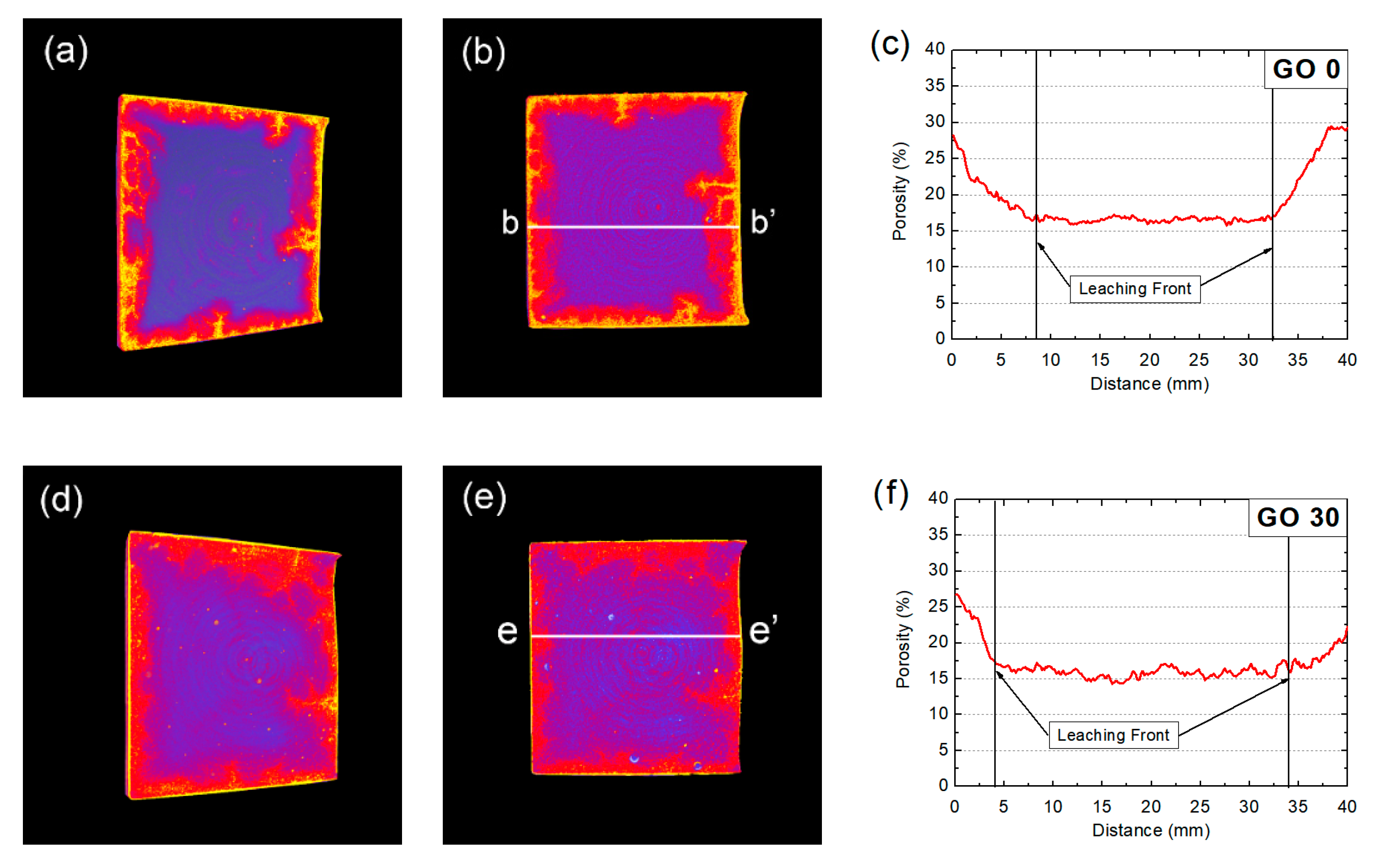

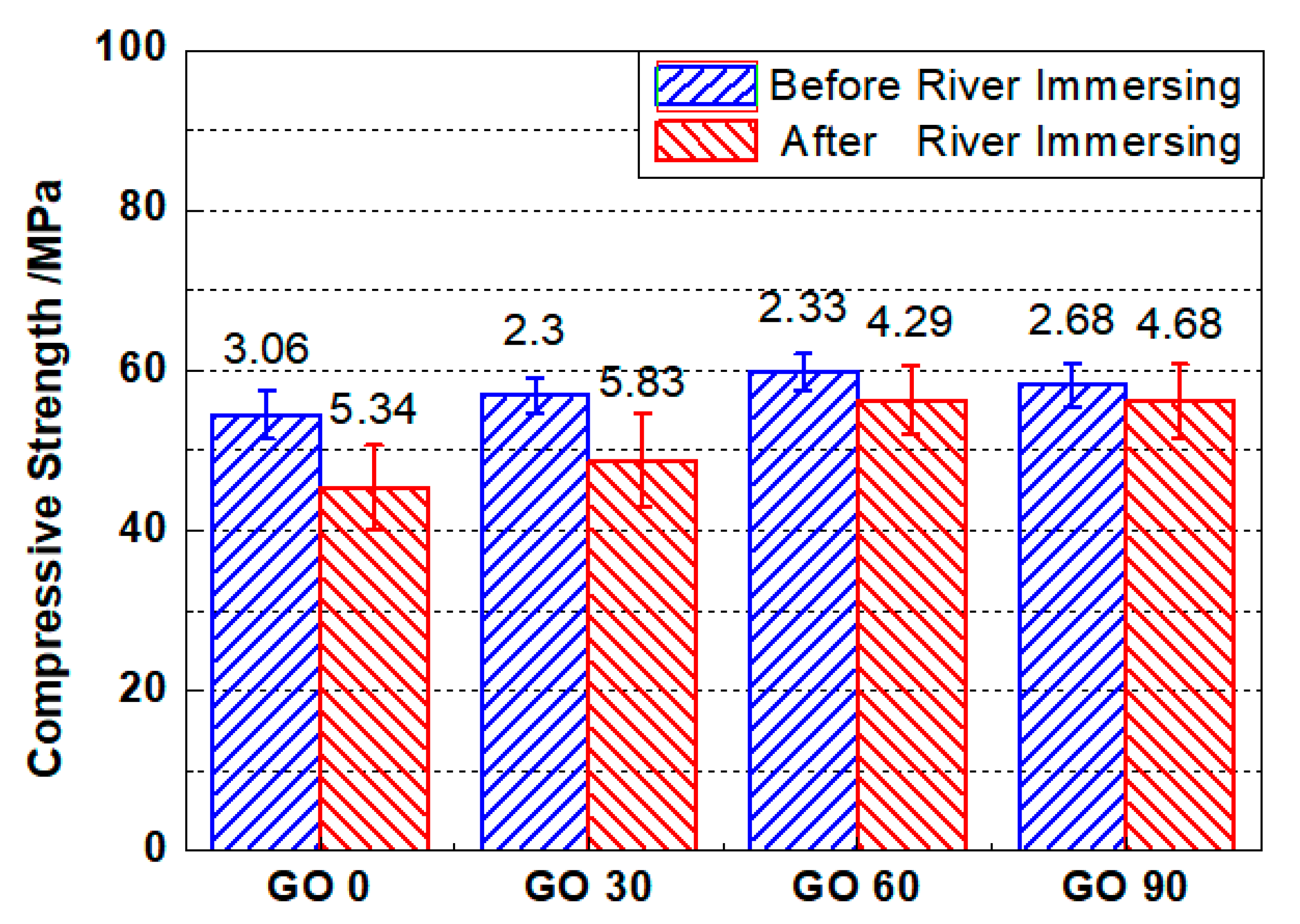
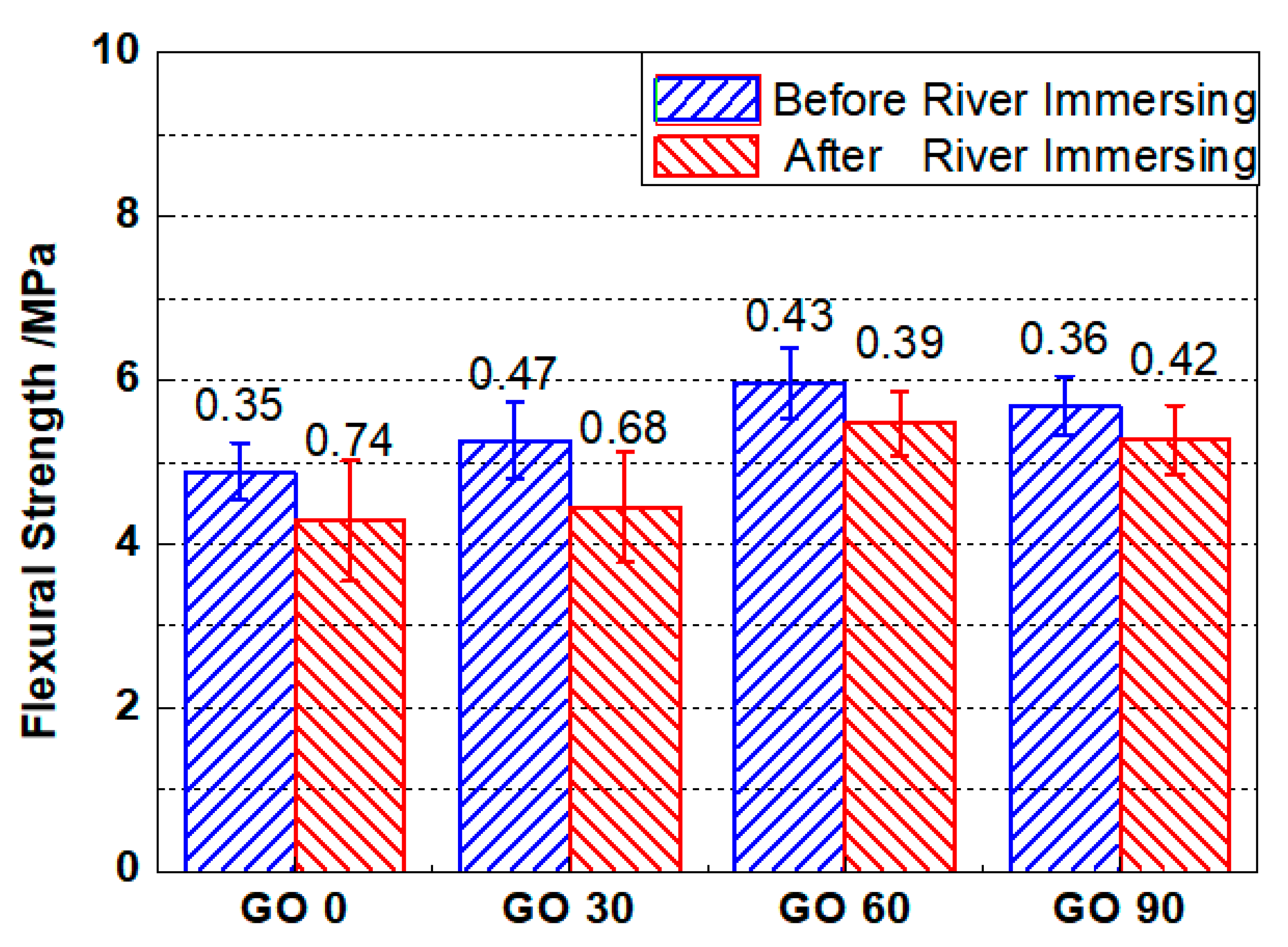
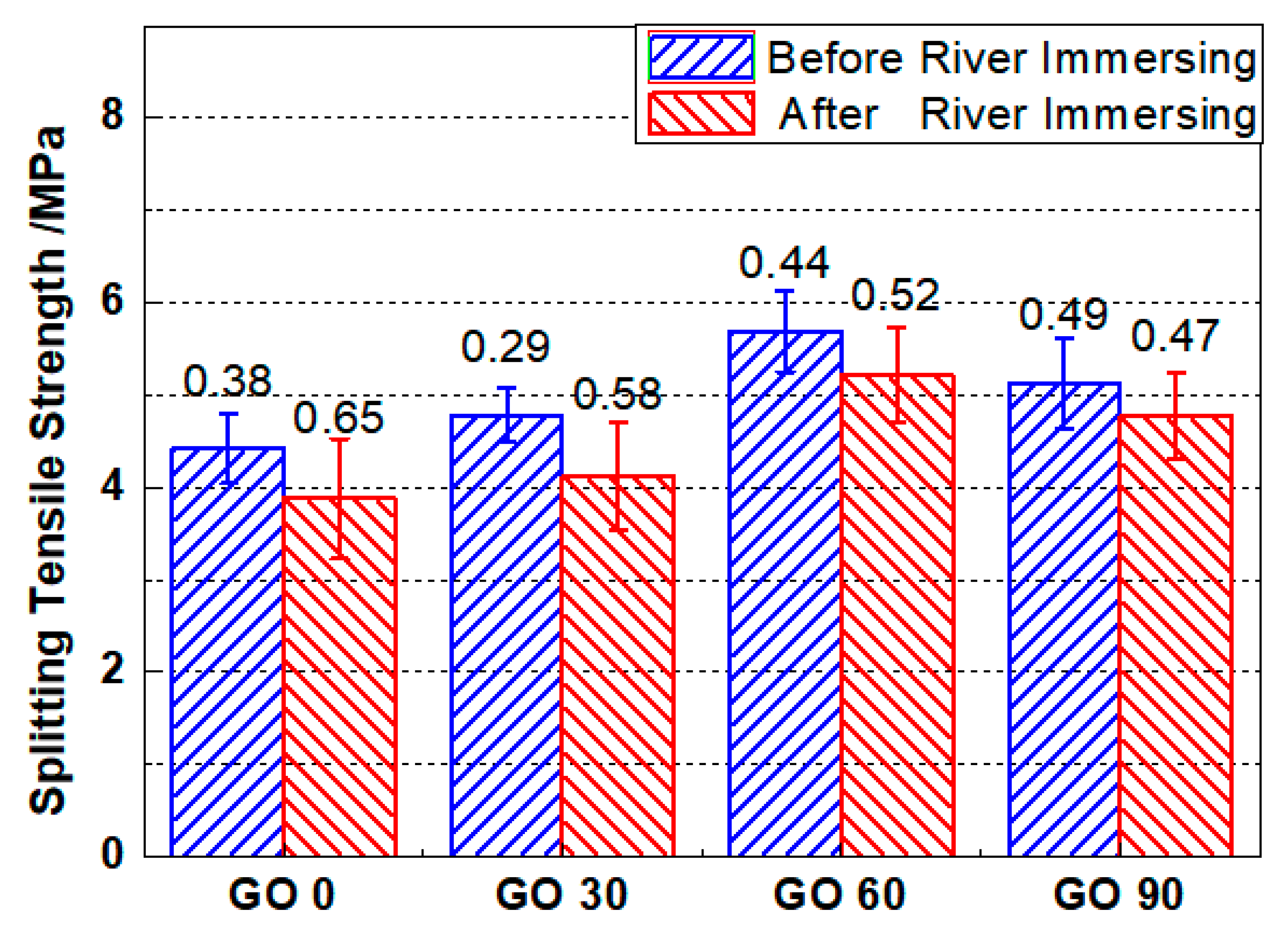
| Binder | CaO | SiO2 | Al2O3 | Fe2O3 | MgO | SO3 | Others | LOI | Total |
|---|---|---|---|---|---|---|---|---|---|
| Cement | 62.60 | 21.35 | 4.67 | 3.31 | 3.08 | 2.25 | 1.29 | 1.45 | 100.00 |
| Fly ash | 8.38 | 47.96 | 30.46 | 5.91 | 2.60 | 1.32 | 3.37 | - | 100.00 |
| Purity | Carbon Content (%) | Oxygen Content (%) | Flake Φ (μm) | Thickness (nm) |
|---|---|---|---|---|
| 97% | 46 | 53 | 0.2–10 | 1 |
| Group | Cement | Fly Ash | Quartz Sand | Water | GO |
|---|---|---|---|---|---|
| GO0 | 613 | 263 | 438 | 263 | 0 |
| GO30 | 613 | 263 | 438 | 263 | 0.2628 |
| GO60 | 613 | 263 | 438 | 263 | 0.5256 |
| GO90 | 613 | 263 | 438 | 263 | 0.7884 |
| Groups Compared | Significance before River Immersing | Significance after River Immersing |
|---|---|---|
| GO0-GO30 | 0.179 | 0.313 |
| GO0-GO60 | 0.001 | 0.002 |
| GO0-GO90 | 0.064 | 0.015 |
| Groups Compared | Significance before River Immersing | Significance after River Immersing |
|---|---|---|
| GO0-GO30 | 0.036 | 0.647 |
| GO0-GO60 | 0.000 | 0.003 |
| GO0-GO90 | 0.003 | 0.010 |
| Groups Compared | Significance before River Immersing | Significance after River Immersing |
|---|---|---|
| GO0-GO30 | 0.147 | 0.345 |
| GO0-GO60 | 0.000 | 0.003 |
| GO0-GO90 | 0.013 | 0.008 |
Publisher’s Note: MDPI stays neutral with regard to jurisdictional claims in published maps and institutional affiliations. |
© 2020 by the authors. Licensee MDPI, Basel, Switzerland. This article is an open access article distributed under the terms and conditions of the Creative Commons Attribution (CC BY) license (http://creativecommons.org/licenses/by/4.0/).
Share and Cite
Cui, D.; Wei, H.; Zuo, X.; Zheng, K.; Wang, Q. Use of Graphene Oxide to Improve the Durability and Mechanical Properties of Mortar Immersed in Flowing River for Three Years. Nanomaterials 2020, 10, 2385. https://doi.org/10.3390/nano10122385
Cui D, Wei H, Zuo X, Zheng K, Wang Q. Use of Graphene Oxide to Improve the Durability and Mechanical Properties of Mortar Immersed in Flowing River for Three Years. Nanomaterials. 2020; 10(12):2385. https://doi.org/10.3390/nano10122385
Chicago/Turabian StyleCui, Dong, Hao Wei, Xiaobao Zuo, Keren Zheng, and Qiannan Wang. 2020. "Use of Graphene Oxide to Improve the Durability and Mechanical Properties of Mortar Immersed in Flowing River for Three Years" Nanomaterials 10, no. 12: 2385. https://doi.org/10.3390/nano10122385






